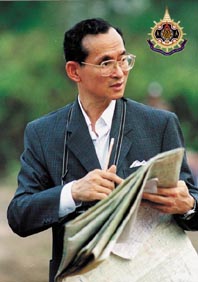 He knelt down and scooped up a
handful of soil which he
He knelt down and scooped up a
handful of soil which he
examined minutely, then let it slip through his fingers. What had
just a year before been a grey, almost barren topsoil was now
brown and fertile. He looked up at the contours of the hills, just the hint of a smile on his face. A farmer testing the suitability of his land for bearing crops? No, it was
His Majesty King Bhumibol Adulyadej verifying the efficacy of one of his royal projects, designed to bring the land back from the devastation of the slash and burn
agriculture practiced by the Hilltribes.
The Thai Monarch is probably best known, universally, for his unbending resolve to improve the lives of each and every one of his people – a singular
dedication to their welfare which has been acclaimed from all corners of the world.
Starting very early in his reign and continuing to this day, the King, usually accompanied by the Queen and second daughter Princess Maha Chakri Sirindorn,
travelled to the far corners of the kingdom to learn first-hand from the farmers and peoples of the rural areas about their problems. Again, as with all his other interests,
the Monarch studies, observes, photographs and imbues himself with all the relevant knowledge and facts which he needs to move forward with recommendations, implementation of
beneficial projects and follow-up.
Even during the height of the 1970 insurgency movements – Muslim secessionists in the south, communists in the northeast and drug warlords staking out
their turf in the north - the King and the Royal Family totally disregarded their own personal safety and continued to travel to highly-dangerous areas to bring hope of a
better life to multitudes of rural dwellers.
A lasting image of the King is that of a man, often kneeling or sitting on the ground, poring over charts and topographical maps of the area, while
surrounded by local farmers and villagers discussing their problems.
It has been recorded that the King has spent more than 200 days per year, for more than three decades, in rural areas where he has initiated some 2,000
projects aimed solely at improving the well-being of his people.
Facing the development dilemma
The King’s philosophy to development problems has been to “keep
it simple” - relying on an intimate knowledge of Nature and her
immutable law, such as using fresh water to flush out polluted water or dilute it through utilization of normal tidal fluctuations. The ubiquitous water hyacinth too can be
‘harnessed’ to absorb pollutants.
The results of any development, the King asserts, must reach the people directly as a means of overcoming immediate problems, translating
into “enough to live, enough to eat”, while looking at a longer-term result of “living well and eating well.”
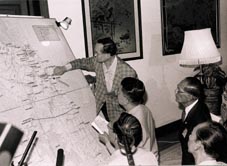 King Bhumibol Adulyadej
reviewing maps and listening to progress reports on 2 October 1993, after appointing Privy Counsellor Mr. Chulanop Sanitwong Na Ayuthaya to administrate the functions at the
“Pak Phanang Waterway Area Development Project”, first implemented by His Majesty in 1992, at the Thaksin Rachaniwed Royal Residence.
King Bhumibol Adulyadej
reviewing maps and listening to progress reports on 2 October 1993, after appointing Privy Counsellor Mr. Chulanop Sanitwong Na Ayuthaya to administrate the functions at the
“Pak Phanang Waterway Area Development Project”, first implemented by His Majesty in 1992, at the Thaksin Rachaniwed Royal Residence.
His Majesty compares this to using “adharma” (evil) to fight evil, observing that both pollution and the water weed are a menace, but they can
be used to counteract each other, thus lessening the damage to the environment.
The King himself practices this “simple approach” and brings an almost “folksy” approach to which the people can readily relate. He studies and
deliberates exhaustively on the particular project and then reveals his thinking in short, easy-to-grasp titles. The very simplicity belies the profundity of the philosophy,
for each title reflects a much deeper insight into a given problem and often, at the same time, hints at the mode of operation to be employed.
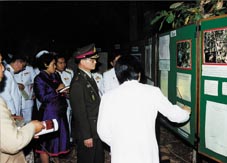 One example, such as “Good water chases bad” refers to the hyacinth/water pollution analogy above. Four waters, three tastes; three forests, four
benefits; reforestation without planting; and, our loss is our gain are some other examples.
One example, such as “Good water chases bad” refers to the hyacinth/water pollution analogy above. Four waters, three tastes; three forests, four
benefits; reforestation without planting; and, our loss is our gain are some other examples.
The King also established six Royal Development Study Centres - or, as they are better known - “Living Museums” - situated in the roughest terrain in
their respective regions.
Three years ago, the King was so intent upon his dedication to the people through his “middle way” - the Buddhist philosophy of balance,
inter-relatedness and self-reliance - that he took a group of journalists to visit the Huay Hong Krai Centre which acts as a model for catchment area conservation for the
north.
These centres are where experiments in re-forestation, irrigation, land development and farm technology are conducted, to find practical application, in
the context of local condition, geography and topography. His Majesty’s aim is to restore the natural balance, to enable people to become self-supporting.
The fact that it was His Majesty’s only press trip for many years indicated the importance that he attaches to these sites where the farmers can observe
the ongoing research and choose whatever is most suitable for their needs and localities.
The first centre organized was that of Khao Hin Son, in the rocky area of Chachoengsao’s Phanom Sarakam District. Here, the centre studies how to turn
the barren soil, caused by de-forestation, back into fertile land again.
The five other centres are located at strategic places around the kingdom. The Pikul Thong Centre at Narathiwat studies the swampy, acidic land of the
southern-most region.
The Phu Phan Centre in Sakhon Nakhon studies soil salinization and irrigation in the country’s biggest region, the Northeast, which suffers from endemic
drought.
The Krung Kraben Bay Centre in Chantaburi examines the rehabilitation of mangrove forests and coastal areas following massive destruction.
The Huay Sai Centre in Petchaburi studies the rehabilitation of degraded forests and shows villagers, in their turn, how to protect the forests.
When he is in doubt, the King will fly over a particular area, armed with aerial photographs and maps of the terrain, noting features as they pass
underneath. But, being a good photographer himself, he also takes his own pictures and later juxtaposes them to obtain a detailed image of the area of his concern, which
helps in his planning of specific development projects.
Through all this, the impression of the Thai King, to much of the world outside Thailand, is of a man clutching a blue-print, a camera at the ready around
his neck, dressed in fatigues and jungle boots, tramping along the remote areas of his kingdom, bringing help, relief and hope to ALL his subjects, particularly the poorest
and most disadvantaged.
The Royal Projects
T
he King undertook the establishment of the Royal Devel
opment Projects in 1969, primarily as a means of arresting the opium growing and deforestation caused by the Hilltribes’ slash and burn agriculture and to improve their
standard of living. The first was established at a Hmong village on Doi Pui in Chiang Mai Province and now has spread to Chiang Rai, Lamphun and Mae Hong Son.
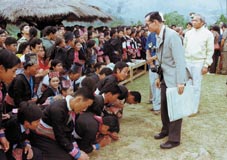 King Bhumibol Adulyadej at the site of the “Mae Lanoi
Project” on 14 March 1992. The project was initiated by a Royal edict from the King himself expanding the growth of elephant grass (typha elephantina) to prevent
erosion in Ban Dong, Huay Hom Sub-district, Mae Lanoi District, Mae Hong Son Province.
King Bhumibol Adulyadej at the site of the “Mae Lanoi
Project” on 14 March 1992. The project was initiated by a Royal edict from the King himself expanding the growth of elephant grass (typha elephantina) to prevent
erosion in Ban Dong, Huay Hom Sub-district, Mae Lanoi District, Mae Hong Son Province.
Over the years, the Project has been instrumental in the conversion of the poppy fields being turned into groves of temperate fruits and vegetables.
Under the dynamic direction of the King’s close colleague, Prince Bhisadej Rajani, who is the director, the Royal Project is celebrating its 31st
anniversary this year and currently has four research stations, 35 Royal Project Development Centres that incorporate some 295 villages, comprising 14,000 households and
approximately 85,000 farmers.
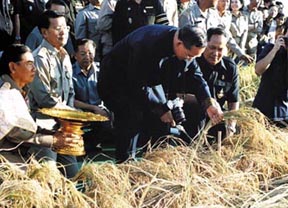 The Royal Development Projects Board, under the Office of the Prime Minister, also serves as the
secretariat for the Chai Pattana Foundation, which is directly responsible for the work related to the Royal Development Projects.
The Royal Development Projects Board, under the Office of the Prime Minister, also serves as the
secretariat for the Chai Pattana Foundation, which is directly responsible for the work related to the Royal Development Projects.
Now, three decades later, the results can be seen in the new life which has come to many of the mountain villages. Greenery has returned to once denuded
forest areas and barren hills and the opium cultivation, a cause of extreme national concern, is virtually a past era.
The Hilltribes, who have been living on their forbidding mountainous terrain, speaking strange dialects and having their own customs, have been long-term
dwellers of the kingdom. Yet, many Thais regard them as alien and threatening.
The authorities, too, have always regarded them with suspicion, as perpetrators of the drug trade and destroyers of the environment. In stark contrast to
the hostile and aggressive tactics of the government authorities which use these pretexts to use violence in forcing them from their lands, the King sees the Hilltribes as
victims of poverty and the drug warlords, a disadvantaged population which needs special help to take part in Thai society.
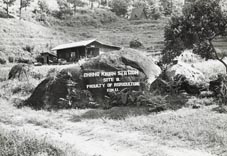 “The key to the success of the Project lies in His Majesty’s guidelines,” explains Prince
Bhisadej. “They focus on obtaining knowledge, through research, avoiding bureaucratic entanglements and swift action to respond to the villagers’ needs, while promoting
self-reliance,” he adds.
“The key to the success of the Project lies in His Majesty’s guidelines,” explains Prince
Bhisadej. “They focus on obtaining knowledge, through research, avoiding bureaucratic entanglements and swift action to respond to the villagers’ needs, while promoting
self-reliance,” he adds.
“The effectiveness of this approach has been applauded internationally. For example, in 1998 the Royal Project won both the “Magsaysay Award for
International Understanding” and the “Thai Expo Award” for attaining the quality standard of Thai Goods for Export.
The King’s own views are that development must respect different regions’ geography and peoples’ ways of life. “We cannot impose our ideas on the
people - only suggest. We must meet them, ascertain their needs and then propose what can be done to meet their expectations,” the King pointed out recently.
The King’s ideas are in direct contrast to the bureaucracy’s wish to impose standards from the top down, with the inflexibility inherent therein. The
King sees no need to spare any sensitivities - if there are any - because he feels that the government approach is costly and authoritarian, which is why it has “failed
miserably to address the country’s problems”.
Year-long Birthday Celebrations
F
ollowing the King’s reaching his sixth-cycle, seventy-
second birthday last December, there has been a year-long celebration, ranging from the opening of Bangkok’s Skytrain, to concerts, to musical interludes, to
elephant parades - a myriad of activities pertaining to Thai life.
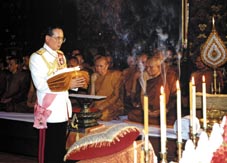 Just recently, the King’s granddaughter, Ploypaylin Jensen played in honour of the King with the
Sydney Symphony Orchestra: it was a much-acclaimed virtuoso performance.
Just recently, the King’s granddaughter, Ploypaylin Jensen played in honour of the King with the
Sydney Symphony Orchestra: it was a much-acclaimed virtuoso performance.
One outstanding landmark was on the 22nd of May when His Majesty reached 72 years, five months and 18 days of age - or 26,468 days old. Thus, the day
after, the 23rd of May, His Majesty became the same age as the erstwhile oldest king of the Chakri Dynasty, King Rama l who founded the line. When King Phra Buddha Yod Fa
Chulalok Maharaj died on the 27th of May 1809, his record, as the oldest king of Thailand, lasted from the Sukhothai through the Ayutthaya and Thon Buri eras up until the
present Rattanakosin period.
On the 24th of May, King Bhumibol added yet another honour to his long list of achievements when his age passed that of Rama I and he became the oldest
king in Thai history.
One would be tempted to recall the song popularized by Dinah Washington in the 1950s or thereabouts, “What a difference a day makes’. For our own King
Bhumibol, the day of Wednesday May 24 made a lot of difference and the Samamongkol Royal Ceremony marked the event.
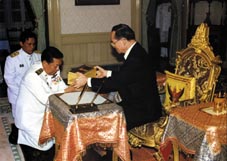 This has been practiced by the Monarch throughout his own long kingship, on many occasions, specifically when his own reign equalled that of King
Chulalongkorn’s 42 years, which it did in 1988, and now last May when his age matched that of Rama l.
This has been practiced by the Monarch throughout his own long kingship, on many occasions, specifically when his own reign equalled that of King
Chulalongkorn’s 42 years, which it did in 1988, and now last May when his age matched that of Rama l.
Other signposts along the way were on the 29th of August 1965 when the King, at age 38, reached the same age as his father, Prince Mahidol of Songkhla. On
the 7th of January 1985 the King reached the same age as his illustrious grandfather Chulalongkorn, at 57 years and 33 days. Another occasion was on the 18th of November 1997
when his 23,260 days of age reached that of his great-grandfather King Mongkut, Rama IV.
The United Nations empowers the people
The King’s development theories have, in fact, been readily embraced by the
United Nations Development Programme (UNDP) and some related UN specialized agencies. Three years ago, UNDP established the Thai-United Collaborative Action Plan which, with
full co-operation from the Royal Thai Government, brought development “to the people, by the people and for the people.” It was based on a holistic “people-centred
development”, with initiatives, plans and implementation of eventual projects coming from the village level - and not imposed from the bureaucracy.
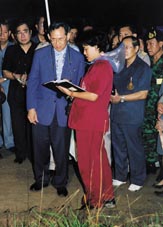 King Bhumibol Adulyadej and Her Royal Highness Princess
Maha Chakri Sirindhorn visiting the King’s project at the “Huay Sai Educational Development Center” in Huay Sai Nya Sub-district, Cha-am District, Phetchaburi Province
on 14 July 1998.
King Bhumibol Adulyadej and Her Royal Highness Princess
Maha Chakri Sirindhorn visiting the King’s project at the “Huay Sai Educational Development Center” in Huay Sai Nya Sub-district, Cha-am District, Phetchaburi Province
on 14 July 1998.
This has been an outstanding success and was implemented within the Eighth National Development - basically the first time Thailand has had a
people-oriented slant to development.
Five provinces were targeted and the projects, now phased out by the United Nations bodies, have gained considerable momentum looking towards the Ninth
Plan and furthering the goals of people power.
The sailing tributes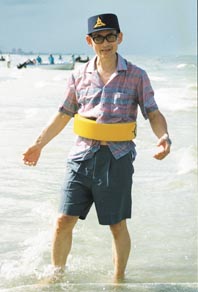
T
he 16th of December this year - celebrated as
Thailand’s National Sports Day -commemorates the 33rd anniversary of one of the world’s greatest sporting records which, given that it was a reigning monarch and his
daughter, is likely to stand in perpetuity. It was the day when H.M. King Bhumibol and HRH Princess Ubolratana stood together on the winners’ podium at the National Stadium
to receive their gold medals from HM Queen Sirikit, for equal-first placing in the OK dinghy section of the Fourth South East Asian Peninsular Games (now the South East Asian
Games).
Another event to be celebrated will be the “Vega Rudder Trophy Race”, this year to be held off the
Klai Kangwol Palace, Hua Hin, where His Majesty is in residence. This long distance race represents the occasion back on 19 April 1966 when the King sailed the OK dinghy he
had built across the Gulf from Klai Kangwol to the Royal Thai Navy Base at Toey Harbour, Sattahip. This crossing, at the time, was mooted as the longest solo crossing of a
waterway, out of sight of land, in an open dinghy.
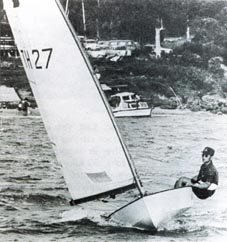 The King presented the rudder of “Vega” as a permanent trophy which will be held on the Western Gulf for the first time in three decades.
The King presented the rudder of “Vega” as a permanent trophy which will be held on the Western Gulf for the first time in three decades.
And, finally, the fourteenth edition of the Phuket King’s Cup Regatta, which opens on Sunday, will be re-dedicated to the King, as has been done every
year since it was inaugurated to celebrate the King’s fifth-cycle, sixtieth birthday in 1987. With a huge fleet and more than 1,000 sailors from 30 countries, this will be
a fitting tribute to the Regatta Royal Patron’s seventy-third birthday on the fifth of December.
|
Epilogue
The book "His Majesty King Bhumibol Adulyadej the Great:
Monarch for the Millennium" was published by
the Pattaya Mail, as a tribute to the King, on the occasion of his seventy-second, sixth-cycle birthday
last December.
As it was highly successful, this year the author Peter Cummins undertook the writing of this special supplement,
published by the Pattaya Mail, to honour the Monarch on the occasion of his seventy-third birthday on Tuesday, 5 December.
This eight-page supplement, "His Majesty King Bhumibol the Great: A life-time of dedication" comes as an
insert in today's issue of the "Mail". In it, Peter has examined HM the King's Development Projects and how they have sustained the country and its people, the
King's own precious subjects.
The supplement looks at the King's philosopy towards development, his study centres ('living museums') strategically
placed around the country and gives a brief overview of the year-long celebrations surrounding the Monarch's seventy-second birthday.
It is the contribution of us all at the Pattaya Mail as our way of wishing His Majesty long life and happiness. |